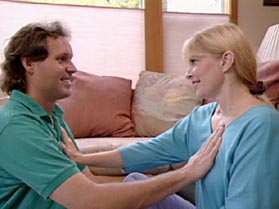What are HIV and AIDS?
How AIDS Works in the Body
HIV Treatment
Who Should be Tested for HIV?
HIV Contraction
Common Misconceptions About Contraction
The Importance of HIV Testing and Diagnosis
How Does HIV Testing Work?
Test Counseling
Conclusion
What are HIV and AIDS?
The Human Immunodeficiency Virus, which is commonly called HIV, is a virus that directly attacks certain human organs, such as the brain, heart, and kidneys, as well as the human immune system. The immune system is made up of special cells, which are involved in protecting the body from infections and some cancers. The primary cells attacked by HIV are the CD4+ lymphocytes, which help direct immune function in the body. Since CD4+ cells are required for proper immune system function, when enough CD4+ lymphocytes have been destroyed by HIV, the immune system barely works. Many of the problems experienced by people infected with HIV result from a failure of the immune system to protect them from certain opportunistic infections (OIs) and cancers.
Defining the terms
People infected with HIV are broadly classified into those with HIV disease and those with Acquired Immunodeficiency Syndrome, or AIDS. A person with HIV disease has HIV but does not yet have any symptoms or related problems, and still has a relatively intact immune system (that is, a CD4+ lymphocyte count greater than 200 cells/mm3). A person with AIDS, on the other hand, has very advanced HIV disease and his or her immune system has incurred significant damage. As a result, people with AIDS are at very high risk for a number of OIs, cancers, and other AIDS-related complications. The Centers for Disease Control have defined the conditions that mark a progression from HIV disease to AIDS. They are: certain infections, such as repetitive pneumonias, Pneumocystis carinii pneumonia (PCP), and cryptococcal meningitis certain cancers, such as cervical cancer, Kaposi's sarcoma, and central nervous system lymphoma CD4+ count less than 200 cells/mm3 or 14 percent of lymphocytes
How AIDS Works in the Body
Before highly active antiretroviral therapy (HAART) became available, most people who contracted HIV eventually progressed to AIDS and had some AIDS-related complication, such as:
- a deterioration of immune system function and an increased risk of infections and cancers
- brain damage that may cause dementia or memory loss
- heart problems that can cause heart failure and symptoms such as shortness of breath, fatigue, and swelling of the abdomen and legs
- severe kidney damage requiring dialysis
- an inability to perform activities of daily living such as balancing a checkbook or driving a car
- metabolic changes that may cause significant weight loss or diarrhea
Due to these potential problems, a person with AIDS is at very high risk of becoming very ill, and, if some action is not taken to protect the person from these infections or reverse the damage done by HIV, he or she is at risk of dying.
The speed of progression to AIDS
The damage caused by HIV occurs more quickly in some people than in others, but generally an untreated HIV-infected person can expect that they will progress to AIDS within 10 years of their infection. During the time the person is infected with HIV, a war rages between the person's immune system and HIV, with HIV slowly wearing the immune system out.
A slow progress: A number of factors can affect how rapidly HIV progresses, some that can be controlled, and some that can't. Some people have certain genes that slow HIV progression, or they are infected with a weak strain of HIV that their immune system is more able to control. In general, taking better care of yourself and following your doctor's advice also slows the progression of HIV disease to AIDS.
A more rapid progress: Factors that may cause a more rapid progression to AIDS are: infection by a virulent strain of HIV, having a high viral load setpoint (a certain level of HIV replication that varies from person to person), older age, and the abuse of drugs or alcohol.
HIV Treatment
In the time between initial infection and AIDS, the infected person may feel relatively normal, despite the constant attack by HIV. People living with HIV have to understand, however, that despite feeling well on the outside, significant damage can be occurring on the inside. Fortunately, over the past five years, significant progress has been made regarding the treatment of HIV and prevention of some of the infections and cancers that may be caused by it. Antiretroviral medications can directly attack HIV and stop it from reproducing and causing further damage. For most people, the biggest factor in preventing progression to AIDS is adherence to HAART, which can suppress HIV replication to very low levels and not allow it to continue to attack the body.
Prophylactic medications In addition to HAART, other steps can be taken to prevent illness in people living with HIV and AIDS. Certain antibiotics, called prophylactic medications, can effectively prevent opportunistic infections. A physician can help to assess the appropriateness of these medications in a particular treatment program, and which ones to use, but it is important that they be taken as prescribed so that infections can be prevented. With careful monitoring, OIs and certain cancers can be detected in their early stages before they have spread, and the antibiotics can work more effectively to ward off further serious complications. I recommend that every person living with HIV or AIDS see a physician for appropriate monitoring and treatment.
Who Should be Tested for HIV?
In the early 1980s, when HIV infections were first starting to appear, HIV was associated primarily with gay men. Then it became associated with intravenous drug users and hemophiliacs. During the past 20 years, however, HIV has become a disease that can affect almost anyone who is not monogamous with an uninfected person.
HIV contraction
HIV is contracted through an exchange of bodily fluids, such as blood, semen, or vaginal secretions. As a result, the most common ways of acquiring HIV are sharing needles while doing intravenous drugs, and sex, especially anal intercourse. While the highest risk of HIV transmission is associated with anal intercourse, vaginal intercourse is becoming a common means of spreading HIV. Vaginal intercourse is the most rapidly growing risk factor for acquiring HIV infection in the United States and in the developing world it is the most common method of HIV transmission. Everyone must take appropriate steps to prevent the spread of HIV: Safer sex with condoms and dental dams and not sharing needles can help prevent the spread of HIV.
Common misconceptions about HIV contraction
People are often concerned that HIV can be contracted through common contacts with an HIV-infected person, such as shaking hands or sharing glasses or eating utensils. These are not risk factors for contracting HIV. There is no evidence that HIV can be spread through these means, and people should not be afraid to be around people who have HIV or to use a glass, eating utensils, or plate that an HIV-infected person has used, or to have other common contacts.
Those who should consider being tested for HIV include:
- people who received a blood transfusion or blood product at any time, but especially in the late 1970s or 1980s
- homosexuals and heterosexuals who have a history of unprotected sex with potentially infected persons
- people who have had multiple sex partners
- people who have had a sexually transmitted disease such as syphilis or gonorrhea
- people who are intravenous drug users
- pregnant women
The importance of testing and diagnosis
The importance of HIV testing and diagnosis has increased over the past five years. Before the improvements in antiretroviral therapies, many people believed that there was little that could be done to prevent the progression of HIV and so they did not get tested. While these people were right about the ineffectiveness of the antiretroviral therapy available at that time, they failed to recognize that medicines had been discovered that could prevent many of the common infections that afflict AIDS patients. Thus, many people were diagnosed with HIV only after they were admitted to the hospital with severe infections, especially PCP. Some died needlessly because they had not sought appropriate medical care and did not receive one of the medications that could have prevented PCP from occurring.
Now, there are even more reasons to seek HIV testing and medical care. Within the past five years, the medicines to prevent infections have been significantly improved and effective antiretroviral therapies have been developed that can not only halt the progression of HIV, but can also reverse much of the damage that has already been done. Therefore, it is important that HIV is diagnosed while the person is relatively healthy and before a major, potentially life-threatening OI occurs, such as PCP or cerebral toxoplasmosis. With HIV, what you don't know can hurt you.
If you think you are at even slight risk of having HIV-if you have had numerous sex partners or if you have had sex with someone who might have been bisexual or had a history of intravenous drug use-you should be tested. If you test positive, you can then receive medical care necessary to keep you healthy and prevent the diseases that occur in untreated AIDS patients. If, on the other hand, you wait until you feel sick before you are tested, you may already have progressed to AIDS and your immune system may already have incurred significant damage that may not be reversible.
Pregnant women
Recent advances in therapy have also led to effective methods of preventing mother-to-child transmission of HIV. Virtually every pregnant woman, especially those who have a history of intravenous drug use, have had sex with someone in a high-risk group, or who have had numerous sexual partners, should be tested for HIV. HIV-infected mothers should consider taking antiretrovirals, which can effectively prevent transmission to the infant. Since breast-feeding can also cause transmission of HIV to the infant, HIV-infected mothers should not breast-feed their infants if there is an available alternative. Many states also require testing of the infant at birth, so that appropriate treatment can be provided.
Testing is voluntary and confidential
Under most circumstances, HIV testing is voluntary. Unless there are special circumstances, most states require a person to give specific permission, called informed consent, before he or she can be tested for HIV. Privacy and confidentiality are legitimate concerns for people who are being tested for HIV. Most people do not want other people or organizations, such as their employer, to know they are HIV-infected and most don't even want them to know that they are being tested. Most states have laws that protect the confidentiality of HIV testing and the diagnosis of infection. While accidental disclosure of a person being HIV positive can occur, in my experience it is extremely rare. It's a mistake to avoid testing because of fear of accidental disclosure.
Also, there are other options including anonymous testing in a clinic or at home (for example, Home AccessR), where you are identified by a number, not by name, and no one but you knows your number. The cost of testing is generally between $30 and $100, and some groups, including many health departments, provide testing free of charge.
How Does HIV Testing Work?
HIV is usually diagnosed by a blood test, but newer tests can be done on saliva or urine. If you're squeamish about getting blood drawn, there are alternatives you can discuss with your doctor. Generally, the purpose of the test is to search for antibodies to the virus. The initial test is an enzyme-linked immunoabsorbent assay (ELISA) and is confirmed using a test called the Western Blot. The antibody tests are very reliable, but may not be able to detect an infection during the first six months after an exposure. There is also a test that can test for the presence of the virus itself, and this test is called an HIV PCR. HIV PCR is used to test for HIV after a potential HIV exposure, but before antibodies have developed. Because infants may have their mother's antibodies in their blood confounding the HIV antibody test, HIV PCR is also useful for them. However, HIV PCR may not be reliable in detecting HIV in all infected patients, especially those with a low viral load.
How long do the results take?
It used to take several days to a week to get test results back. Now there are rapid detection methods that allow reliable results in less than an hour. As a result, HIV testing can be completed while you are still in your doctor's office.
Test counseling
Pre-test and post-test counseling and education are important parts of HIV testing. Counseling gives people who test negative for HIV an opportunity to learn more about HIV and how to avoid becoming infected. For those who test positive for HIV, counseling gives them a chance to learn about the importance of being medically evaluated and, if appropriate, treated so as to prevent disease progression or OIs. These counseling sessions take about 15 minutes, including time for questions. They are a very valuable part of the testing process, regardless of the test results.
Conclusion
HIV disease is a chronic disease that used to be fatal for virtually everyone who got it. Now, things have changed and effective treatments are available to treat HIV and, in most cases, these treatments can prevent HIV from doing further damage and can keep the person healthy. In order to take advantage of these treatments, you must be tested and diagnosed with HIV. All persons who may have been infected with HIV and virtually all pregnant women should be tested as soon as possible.
Brian Boyle, MD, JD, is an Attending Physician at the New York Presbyterian Hospital-Weill Cornell Medical Center and Assistant Professor of Medicine in the Department of International Medicine and Infectious Diseases at Weill Medical College of Cornell University. Dr. Boyle has authored and co-authored more than 100 publications and abstracts relating to the treatment of HIV and hepatitis. In addition, he has lectured across the country on the latest advances in the treatment of HIV, Hepatitis C Virus and Hepatitis B Virus as well as many other HIV/AIDS and hepatitis related topics.
next: HIV, AIDS, and Older Adults







